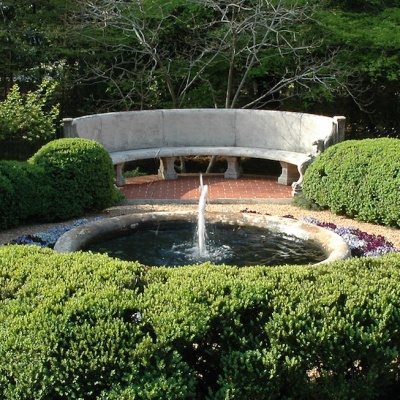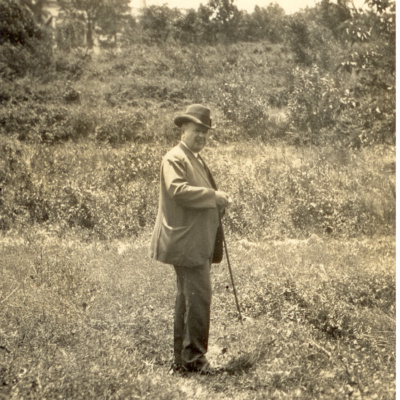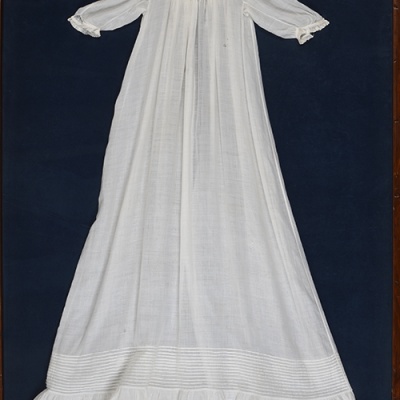A Pearl in a Bank of Moss
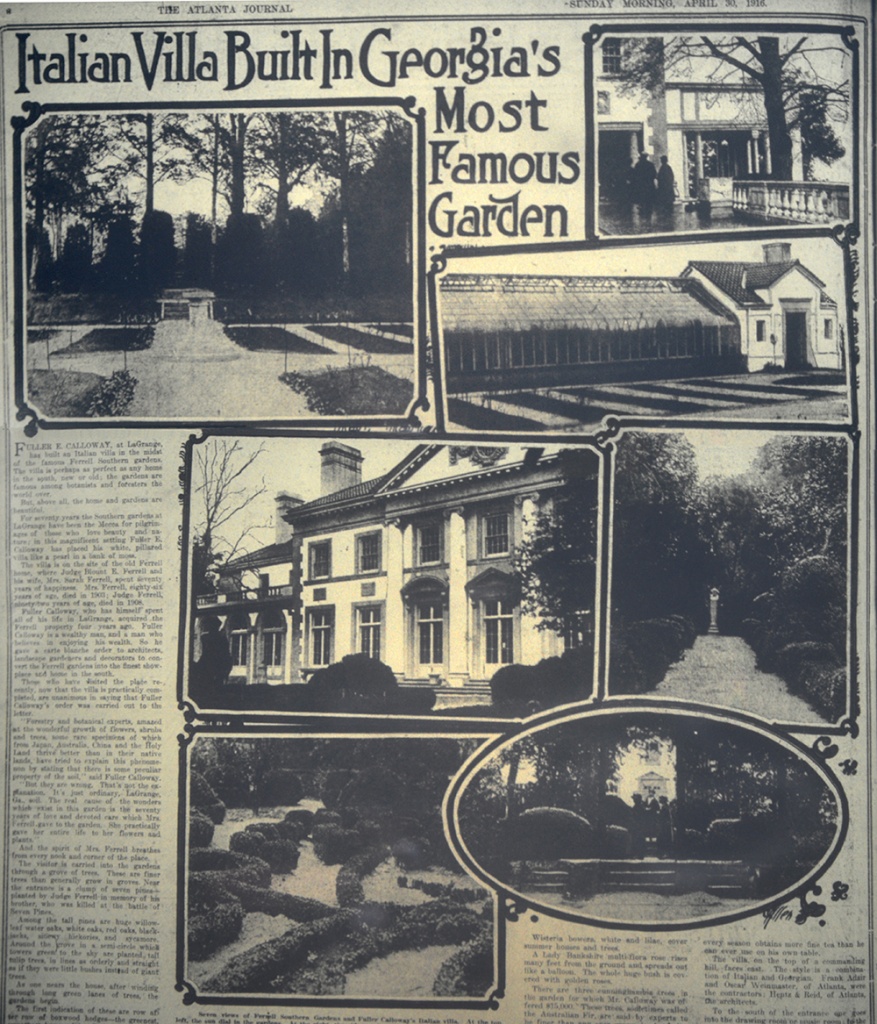
On April 30, 1916 The Atlanta Journal ran an article entitled “Italian Villa Built in Georgia’s Most Famous Garden,” which glowingly described the thoroughly unique setting for the newly completed Fuller E. Callaway home. It is easy to picture Fuller and Ida as they read the article being pleased with the coverage, yet vexed that their very name was misspelled throughout!
As it is customary for The Portico to have a garden feature and as we observe the centennial year of the construction of the house, it seems fitting to print an excerpt of the 1916 article in this edition. So hearken back 100 years to a time of more gracious commentary—albeit with hyperbole, misspellings and a few horticultural inaccuracies—but fun to revisit nonetheless:
Excerpt from the April 30, 1916 edition of The Atlanta Journal:
Fuller E. Calloway, at LaGrange, has built an Italian villa in the midst of the famous Ferrell Southern gardens. The villa is perhaps as perfect as any home in the south, new or old; the gardens are famous among botanists and foresters the world over.
But, above all, the home and gardens are beautiful.
For seventy years the Southern gardens at LaGrange have been the Mecca for pilgrimages of those who love beauty and nature; in this magnificent setting Fuller E. Calloway has placed his white, pillared villa like a pearl in a bank of moss. . . .
“Forestry and botanical experts, amazed at the wonderful growth of flowers, shrubs and trees, some rare specimens of which from Japan, Australia, China and the Holy Land thrive better than in their native lands, have tried to explain the phenomenon by stating that there is some peculiar property of the soil,” said Fuller Calloway.
“But they are wrong. That’s not the explanation. It’s just ordinary, LaGrange, Ga., soil. The real cause of the wonders which exist in this garden is the seventy years of love and devoted care which Mrs. Ferrell gave to the garden. She practically gave her entire life to her flowers and plants.”
And the spirit of Mrs. Ferrell breathes from every nook and corner of the place.
The visitor is carried into the gardens through a grove of trees . . . As one nears the house . . . the gardens begin. The first indication of these are row after row of boxwood hedges—the greenest, smoothest boxwood in all the world. Enclosed in these green borders are flowers and shrubs from the four corners of the earth.
Terraces rise one above the other as one nears the villa; long green vistas appear between aisles of giant tree boxwood twenty feet high—vistas ending in marble busts and statues. . . .
Each one of the . . . terraces is a garden in itself, with the largest garden of them all on the topmost terrace.
The amazing lines of boxwood wind in endless green borders everywhere. The usual dwarf box is very much in evidence, but growing so thick and so luxuriantly that it looks as if the many little shrubs grew sideways along the ground in one solid, pipe-like vine. Then there are many fine specimens of hedge-box, which rises to about ten feet in height. . .
Near the house are two unique mottoes planted in box. One is the motto of Mrs. Ferrell—“God Is Love.” The other is the motto of Judge Ferrell, a stern jurist and just man—“Fiat Justicia”—“let justice be done.”
There are many other unique words, figures and designs in box. At one entrance to the garden “God” is spelled in huge letters. Fuller Calloway’s little son tried to read this and did so—but backwards, “dog” was the way he read it. . . .
. . . One of the prettiest designs of all is a group of dwarf-box bushes arranged in the form of a cluster of grapes.
Tea olives, with flowers the scent of which is so sweet as to be nearly overpowering, grow to heights of twenty feet.
Four hundred magnolias, comprising twenty-three varieties, add their lustrous blossoms and smooth leaves to the riot of flowering color.
Wisteria bowers, white and lilac, cover summer houses and trees.
A Lady Bankshire multi-flora rose rises many feet from the ground and spreads out like a balloon. The whole huge bush is covered with golden roses.
There are three cunninghambia in the garden for which Mr. Calloway was offered $15,000. These trees, sometimes called the Australian Fir, are said by experts to be finer than any ever grown in Australia, their native habitat.
There are cedars of Lebanon from the Holy Land; bay from Portugal, bay from England, and the true bay with a leaf as fragrant as oriental spices.
English Yew trees rise to stately heights; Japanese varnish trees, with bright, green-blue branchless trunks, add a touch of the unusual.
Crepe myrtles of all shades and colors blossom in all parts of the grounds; there are anise trees; a wonderful maiden-hair tree with leaves as delicate as those of the maiden-hair fern; . . . cryptomera trees, like firs done in lace, add grace and beauty to the scene.
Old fashioned climbing roses cling to summer houses and bowers; rhododendrun and mountain laurel grow in profusion; near the house is a hedge of Chinese tea . . . from which Mr. Calloway every season obtains more fine tea than he can ever use on his own table. . . .
The piece then rather abruptly concludes with twelve matter-of-fact sentences about the house itself, leaving the author’s high regard for its environs quite obvious. But also made apparent was the care being given to Mrs. Ferrell’s masterpiece by its most recent owners as their new home was placed to overlook the garden. For today’s reader, it is remarkable to realize how recognizable the estate’s garden today is to the one described a century ago. The same terraces are redolent with magnolia, tea olive and old roses while amazing lines of boxwood still form mottoes, grapes and other cherished designs. The cunninghamia and ginkgo planted in the 1800s cast shade where they always have; tea hedges, crepe myrtle, yew and cryptomeria continue to enhance lovely vistas. How fortunate we are that, with characteristic vision, Fuller and Ida sought to preserve Sarah’s life’s work and to impart that spirit of preservation to the next generation who lived here—Fuller, Jr. and Alice. Now the reins have been passed again, yet the goal of timeless endurance for this beloved old place remains the same.
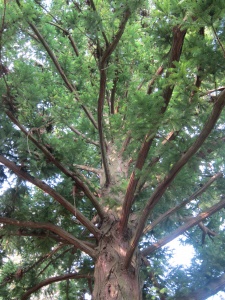
Mrs. Ferrell’s cunninghamia, mentioned in the article, still casts beautiful shade today.
